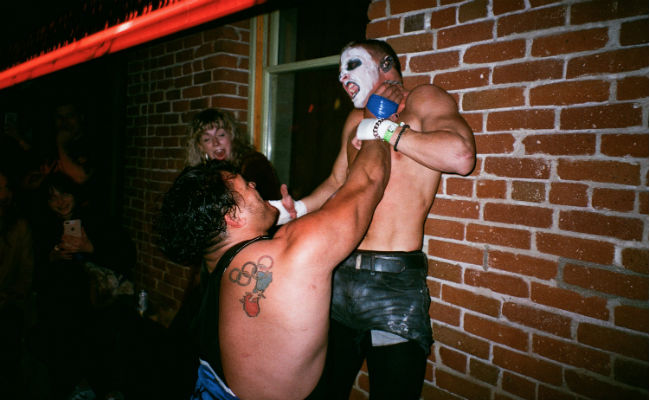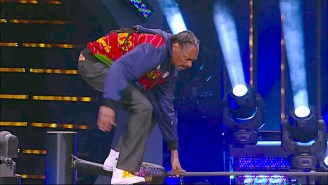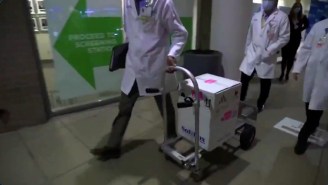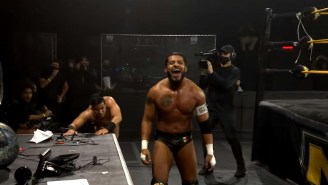
Independent wrestling‘s recently-notorious goth queen Priscilla Kelly and rising local star Heather Monroe duke it out at the Hi Hat in Los Angeles on a Sunday night. The crowd is gathered as close as the referees will allow around a sound stage, atop which Kelly is poised. “It’s not my time of the month,” she says, “Or I’d shove a tampon in your mouth,” before opting for a more traditional finishing blow than death by feminine hygiene product, a painful-looking splash to her opponent prone on the concrete floor covered by a thin carpet. This earns her the three-count and the audience loves every second of it.
The use of high risk, high flying wrestling moves in unusual terrain is about as traditional as it gets at the unconventional Suburban Fight, the year-old indie that recently gained mainstream media attention when a video of a spot in which Priscilla Kelly shoved a tampon in Tuna’s mouth went viral. The moment was covered by outlets like TMZ and drew a spectrum of reactions from the wrestling world, from praise and criticism, disgust to excitement. But though this was the first to involve a feminine hygiene product, wrestlers have been doing things just as extreme at Suburban Fight since the promotion’s inception.
When creator, event manager, and booker Madison Woodward first pitched the idea of the Suburban Fight, he says he thought it was too out there to be approved. “I’ve been booking shows for about ten years, mainly punk shows,” Woodward says. “I was working at a venue and some of the events I was doing were going well. The manager asked me if I had any other ideas for other events, and I was like, ‘Man, I got this crazy idea.’ One hundred percent did not think he was going to go for it to do, you know, no ring, basically like bar fights in the bar. He got stoked.”
The manager “had to go through some legal stuff to make sure it was possible,” but once that was worked out, the shows began. The promotion had some evolving to do. At first, Woodward’s punk background led to punk bands playing at the events, which he thought “was really cool.” But this non-wrestling interlude of a wrestling show “kind of turned into an intermission,” which Woodward felt wasn’t “fair to the bands. Like, I wouldn’t want to be up there playing and everybody would be like, ‘Okay, let’s go get a drink now.'” When a band canceled two days before an event, Woodward just added another match to the card. Suburban Fight has yet to reintroduce live music to their shows. “I just think the flow works so much better,” Woodward explains.
Another, more critical development in how Suburban Fight works is the unique role of its referees. With no ring and basically no rules, the refs work mainly as crowd control, keeping audience members a safe distance away from the always-moving action, with their only role in the actual matches to count pins.
“They are vital for sure,” Woodward says. “When we started, it was like one ref each match, and then we were like, ‘No, it’s got to be two refs. Wait, maybe we should have two refs and like a guy or two guys kind of holding people back’… It’s a totally immersive experience and I think that’s what people love about it. Obviously, they love filming it and showing their friends it and sending it out to their social network. But by doing that, I feel like they don’t pay attention all the time and, you know, if there’s a 250-pound person running at you, like, you need to move, and it’s good to have a few people, such as the refs, kind of there to keep an eye on that. God bless ’em.”
https://twitter.com/RobertCollard/status/1102418543277047808
The immersive, interactive element isn’t just a safety concern for management – it’s a big part of Suburban Fight’s appeal. Its audience is a mix of hardcore indie wrestling fans and people who have never been to a wrestling show before. Before the first Suburban Fight show I went to, people in wrestling shirts – mostly representing wrestlers on the show, AEW, or NJPW – speculated with each other in-depth about the goings on in the wrestling world, while a common topic of conversation in groups of people not clad in merch seemed to be Escape Rooms.
That’s not a coincidence – like Escape Rooms, Suburban Fight shows are events that have to be experienced in-person in a world where so much entertainment can be accessed on a screen. Though a few of the promotion’s matches are on their YouTube channel and their crossover shows with GCW are available to watch on Fite (here and here), most online footage of Suburban Fight, including the infamous tampon spot, is from people filming the insanity with their phones.
That makes them not only intriguingly niche for wrestling fans, but an attraction for people looking to have unique experiences. And for those looking for exciting content to share on Twitter, Instagram, et cetera, it doesn’t get much more FOMO-inducing than a video of, for example, a man skateboarding onto another man in a bar, shot from five feet away. It’s like the Museum of Ice Cream, but with an element of endorphin-boosting danger.
wrestling in 2019 ty @Suburbanxfight ty @boy_myth_legend @DarbyAllin don’t fuckin @ me jim cornette i’m talkin 2 u pic.twitter.com/mJYatp0TDF
— stone cold brew austin (@stonecoldbrew) February 25, 2019
Woodward is aware that these different groups exist within his promotion’s audience. “I’d say fifty percent of the audience has no interest in wrestling. They have interest in this event,” he says. “It’s like a new genre, I think is probably the best way to put it, and I think maybe people who have some reservations with wrestling are willing to do this, to go to an event like this, because it is a different experience… I think they want to be there and capture what’s happening. They don’t know what’s going to happen and, really, anything could happen, and that excites them, and they want to, like, be there within arm’s length of it.”
The quintessential liveness of the Suburban Fight experience is part of why so little of it has been officially filmed and put online, but that could change. According to Woodward, “There is interest in making this, I guess, something bigger than it is… There is interest in creating some kind of show or some way to watch everything, but that’s the whole thing… getting over that hurdle where we need to capture it in a way that you’re still first-person… like you’re right there, because that’s where the excitement is.”
Another element of Suburban Fight that’s important to Woodward is creative freedom for performers, which is what ultimately led to the recent viral exposure gained by the promotion. “I’m a booker in the sense that I have an idea for a match, but I want it to be totally inclusive… This is [the wrestlers’] art, man, and they’re like traveling around the world doing it. Like, I want them to be psyched on what they’re putting out there and psyched on what they’re doing that night. Because a lot of nights they’re not, and that sucks.”
He says the best way to describe the pre-show creative process is “we all come up with ideas and then it runs from there,” and that he’s pitched spots to wrestlers that have been used in Suburban Fight shows. But “the tampon thing” was entirely Priscilla Kelly’s brainchild, an idea she brought to Woodward that she said everyone else to which she’d previously pitched it had turned down. When the idea became a reality, “I’ve never heard a reaction at a wrestling show like that. Men were screeching, like, louder than women, and every woman, including my girlfriend, like ran to the front. Like, they couldn’t believe it and they were filming it… To men, it was horrifying. To women, it was, like, empowering… I thought it was beautifully done and it was incredible.”
“That being said,” Woodward adds, “I did not realize it was going to do what it did… I wouldn’t say it put Priscilla on the map or anything, but it pushed her career… She is [a free agent] and I think this is the best time for her to be independent, with so much going on in wrestling, and she’s a real talent with really amazing ideas… It obviously brought attention to what we’re doing, but it rewarded her for the creativity that she has.”
The combination of the success of the tampon spot and a real-life injury has become a bona fide pro wrestling rivalry between the women involved. Kelly vs. Tuna II was the most-hyped match for their February 24 show, but a broken foot took Tuna off the card. Though Heather Monroe took her spot in the match, Tuna came to the show as a guest commentator, and Kelly, of course, antagonized her, saying she broke her foot because she doesn’t know how to wrestle. This led to Tuna, still in a boot, giving Kelly a DDT on the stage that built the anticipation for their rematch and that the audience was extremely into. Woodward promises, “It’s going to happen… I think it’s something that all three of us really want and I’m ready to go whenever they are.”
If you want to keep up with that and all the other crazy stuff going on at Suburban Fight, you can follow them on Twitter and Instagram. But really, nothing compares to watching the action in person, very close to your own eyes.






